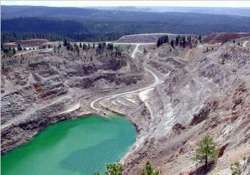Uranium Mine In AP Could be Among World's Largest
Rawatbhata, July 19: India`s nuclear power aspirations has got a boost as the Department of Atomic Energy (DAE) has discovered that the upcoming uranium mine in Andhra Pradesh's Tumalapalli has close to 49,000 tonnes of

Rawatbhata, July 19: India`s nuclear power aspirations has got a boost as the Department of Atomic Energy (DAE) has discovered that the upcoming uranium mine in Andhra Pradesh's Tumalapalli has close to 49,000 tonnes of uranium — three times the original estimate of the area`s deposits, reports Times of India.
In fact, there are indications that the total quantity could go up to 1.5 lakh tonnes, which would make it among the largest uranium mines in the world.
The quantity is sufficient for supporting a nuclear power plant of 8,000 MW capacity for 40 years. Production will start in six months. Srikumar Banerjee, secretray of DAE and chairman of the Atomic Energy Regulatory Board, announced the discovery during the foundation stone-laying ceremony of the seventh and eighth units of the Rawatbhata atomic power project.
"It`s confirmed that the mine has 49,000 tonnes of ore, and there are indications that the total quantity could be three times of that amount. If that be the case, it will become the largest uranium mine in the world. The plant is ready, and will begin production by the end of this year," Banerjee said.
Now, India has two functioning uranium mines — both in Jharkhand. The total reserves are estimated to be in the range of 1,70,000 tonnes. The discovery of the Tumalapalli deposit has at one stroke boosted the availability of uranium, lowering the country`s dependence on foreign supplies.
India has been procuring uranium on various terms from countries like France and Kazakhstan but does not yet have a long-term supply contract.
India continues to fancy nuclear energy as a possible solution for its energy needs. Unlike some other countries which have been forced to temper their enthusiasm for nuclear energy post-Fukushima, the UPA government is persisting with its push for what is considered to be the cleanest source of energy.
The fact that Tumalapalli may have uranium reserves has been known for a while, but it took four years for the estimate to come to the present level from 15,000 tonnes in 2007. A 220-MW plant requires 45 tonnes of uranium per year, a 540-MW plant needs 80 tonnes and a 700-MW plant requires 100 tonnes per year.
Banerjee said that the fact that the usual acidic method of leaching would not have worked in Tumalapalli took some time for a full exploration of the reserves. "We developed the method of acidic leaching in the Jadugoda mines in Jharkhand. Subsequent exploration showed that reserves are spread across a 35-km radius," he said.
The countdown has started for the seventh and eighth units of the Rawatbhata power project, which is all set to have two indigenously built 700 MW capacity plants — the biggest in the country. The plants, being built at a cost of Rs 12,000 crore, are likely to be ready by 2016. As per the revised policy, 50% of the energy output will be for consumption in Rajasthan, and the rest will be given to the Northern Grid.
S K Jain, CMD of the Nuclear Power Corporation India Limited, announced plans of constructing 14 plants of 700 MW capacity each over the next few years.